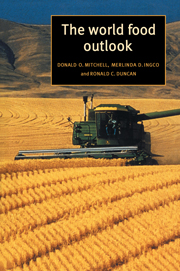Book contents
- Frontmatter
- Contents
- List of figures
- List of tables
- Preface
- List of abbreviations
- 1 The world food problem
- 2 The price of food
- 3 Gains in consumption levels
- 4 World food production increases
- 5 Population growth and food demand
- 6 The quantity and quality of the resource base
- 7 Raising yields
- 8 Changing consumption patterns
- 9 Simulating the future world food situation
- 10 The world can feed twice as many in twenty years
- 11 A robust prediction?
- 12 Africa presents a special challenge at the turn of the century
- Appendix The World Grains Model
- References
- Index
5 - Population growth and food demand
Published online by Cambridge University Press: 06 November 2009
- Frontmatter
- Contents
- List of figures
- List of tables
- Preface
- List of abbreviations
- 1 The world food problem
- 2 The price of food
- 3 Gains in consumption levels
- 4 World food production increases
- 5 Population growth and food demand
- 6 The quantity and quality of the resource base
- 7 Raising yields
- 8 Changing consumption patterns
- 9 Simulating the future world food situation
- 10 The world can feed twice as many in twenty years
- 11 A robust prediction?
- 12 Africa presents a special challenge at the turn of the century
- Appendix The World Grains Model
- References
- Index
Summary
Population growth is the most crucial determinant of food demand. Other demand determinants, such as income or price changes, generally have less of an effect on food demand. Developing economies which have low population growth rates have had the most success in increasing per capita food consumption, while those with high growth rates have had difficulty in maintaining or increasing consumption. But there is not a direct line of causation from the population growth rate to per capita food consumption. Rather, economic policies which lead to good economic performance, including good agricultural performance, in time lead to lower population growth rates.
World population reached an estimated 5.3 billion in 1990, increasing 75 per cent from 1960 to 1990. In the next 30 years, world population is projected to increase by a further 50 per cent (United Nations 1991). Despite this projection of slower growth, world population will actually increase by 2.8 billion in this period and will provide a formidable challenge to world agriculture.
During the 1960s and 1970s, population growth accounted for one-half of the increase in total cereals consumption in developing economies and two-thirds of the increase in industrial economies (table 5.1). Cereals consumption and population growth slowed during the 1980s, possibly reflecting slow economic growth or a curbing of growth in per capita demand for cereals. Cereals consumption growth during the 1980s was about 3 percentage points faster than population growth. In industrial economies, cereals consumption increased by 9.5 per cent during the 1980s, while population increased by 6.1 per cent. In developing economies, cereals consumption increased by 27 per cent and population increased by 23 percent.
- Type
- Chapter
- Information
- The World Food Outlook , pp. 34 - 43Publisher: Cambridge University PressPrint publication year: 1997
- 1
- Cited by



